Select image to enlarge and view caption.
Valleys and Hills Region
What makes this region unique
The unique characteristics of the Valleys and Hills Region shape the fish and wildlife that inhabit it. When you visit the far southwestern part of the state, you’ll find that the environment shares characteristics with the Gulf Coast due to the region’s frequent flooding cycles. You’ll have the chance to see a variety of trees, ranging from massive trees covering wet soils to sparse oaks covering dry regions.
If you’re walking through open, grassy spaces next to wet environments, you might discover a crawfish frog or two, as they inhabit crawfish burrows to wait for unsuspecting insects at the entrances. In the swampy areas of the region where trees mix with thickets of other vegetation, you might be surprised to know you’re sharing space with the rare swamp rabbit. If you tour where the Wabash and Ohio rivers open up, you could see where river otters and turtles with swirled shells thrive.
The Valleys and Hills Region is also home to a vast complex of grasslands that transition to wetlands and support many migratory birds who use the area to rest and feed when migrating north or south. If you visit, you may see the stately whooping crane. Its Eastern population comes through Indiana in the spring and fall.
The region is also unique in that it is home to fish and wildlife that thrive in its remaining wild places.
State wildlife action planning in the Valleys and Hills region
In June 2023, partners from the Valley and Hills region convened to discuss the ecosystems that are in need of conservation in the region. Then, conservation strategies were built around the most pressing threats to these ecosystems. In 2024, we’ll be working with partners to further refine elements of the regional plan. Partners who have not been involved in the work are welcome to participate in the refinement process.
Curious about who has been involved in the process? Check out our list of partners below.
- Thank you, partners!
- DNR Division of Fish & Wildlife
- DNR Division of Nature Preserves
- DNR Division of State Parks
- Friends of Goose Pond
- Hoosier Environmental Council
- Indiana BASS Nation
- Indiana Department of Environmental Management
- Indiana Department of Environmental Management -- Office of Water Quality Wetlands
- Indiana Department of Transportation -- Environmental Services
- Indiana Forest and Woodland Owner's Association
- Indiana Native Plant Society
- Indiana Parks Alliance
- Indiana Sentinel Landscape
- Knox County SWCD
- Lochmueller Group
- Natural Resources Conservation Service
- Patoka National Wildlife Refuge
- Pheasants Forever/Quail Forever
- Sam Shine Foundation
- The Nature Conservancy
- U.S. Fish and Wildlife Service Private Lands
- Wesselman Woods
Interested in learning more about the progress of the Valley and Hills regional plan? Contact Elizabeth Mabee (SWAP@dnr.IN.gov; 463-203-3095).
Conservation at work
- Fire encourages use of grasslands by songbirds, animals, and wildlife watchers
In spring, public land managers in the Valleys and Hills Region participate in prescribed burns. The burned, open fields attract songbirds and other animals while simultaneously warding off grass and woody encroachment. Kalli Dunn, property manager at Goose Pond Fish & Wildlife Area, is assisted by DNR Fire Headquarters when conducting prescribed burns on Goose Pond FWA and maintaining the property’s habitats for wildlife. Prescribed burns benefit the area by controlling the shrubs and the thickness of the grass so species can properly move through it while also encouraging some plants to flourish and feed wildlife. The habitat effects of prescribed fire are essential to creating nesting and foraging habitat for many species of native wildlife such as Northern bobwhite and Eastern cottontails. The native plants encouraged by prescribed burns also support insect diversity by further increasing the variety and amount of food for them in the area.
The prescribed burns Dunn conducts at Goose Pond FWA help fill in gaps of missing landscape types. After burning areas, she’s seen turkey populations and increased wildflower production. Not only does the restoration benefit the wildlife, but it also benefits its users. Birders have enjoyed increased access to the post-burn areas. “It’s a mutually good thing,” Dunn says. “(I appreciate) the ability to physically manipulate the landscape to encourage the habitat that’s missing to support the wildlife.”
Learn more about Goose Pond FWA.
Learn more about how DNR uses prescribed fire.
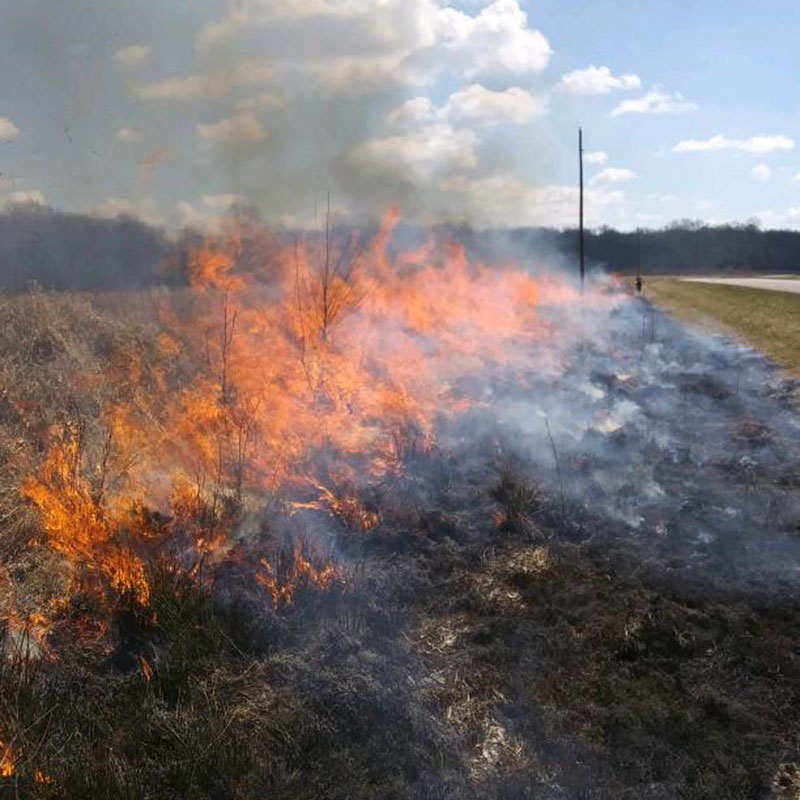
DNR staff conduct a prescribed burn.

- Hunting access, grassland bird habitat, cleaner water and healthy soil—a project for all
Minnehaha Fish & Wildlife Area, a former Division of Fish & Wildlife property in Sullivan County, was leased from a local coal company. Eventually the property was sold to private landowners. One landowner, a retired Division of Fish & Wildlife employee, wanted to turn the land into a quality habitat for upland game birds and thus increase Northern bobwhite populations for hunting. Nate Yazel, a wildlife biologist, worked with the landowner to renovate the area. Together, they reduced invasive shrub species and disced grass to open up the land while providing increased hunting opportunity in the area. They continue to conduct grassland habitat management by spraying plants with herbicide, tilling, establishing native grass and pollinator plantings, and planting trees.
Yazel is happy to see the successes that have happened to the area after it was mined. His work impacts Species of Greatest Conservation Need such as dickcissel, Henslow’s sparrow, and Indigo buntings. Along with the species’ needs being met, Yazel’s work also meets the needs of the public. “We are doing habitat work that we think is important,” he says. “We are providing clean water, clean air, healthy soil, and abundant wildlife with this project.”
Learn more about Grasslands for Gamebirds and Songbirds.
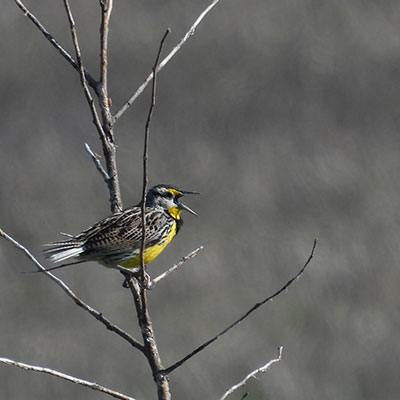
An Eastern meadowlark flourishes in grasslands.
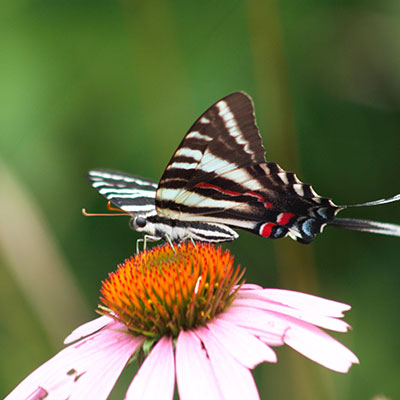
A zebra swallowtail butterfly rests on a purple coneflower as they both benefit from grassland work.

- Invasive tree management on public land provides habitat for bats, birds, and squirrels
At Sugar Ridge Fish & Wildlife Area (FWA), native species compete with invasive species for space in the woods. Hillary Bulcher, Sugar Ridge FWA property manager, worked with the National Wild Turkey Federation and volunteers to remove invasive species at Sugar Ridge and support native species’ return in the spring. By completely removing the bark from around circumferences of trunks and spraying herbicide in the bark, they safely killed off the invasive trees. These standing dead trees provide summer roosts for Indiana bats, attract insects for woodpeckers to eat, and provide nest sites for birds and squirrels.
By removing the invasive trees, Bulcher helps thicker and diverse native vegetation grow on every level of the forest, with plant types ranging from large trees to spring wildflowers. While Bulcher appreciates what her efforts do for nature, she also loves what they do for the public. Managing invasive species on public lands serves as an educational opportunity for those who may not understand the damage the species can do. “(Our work) creates conversations,” Bulcher says. “You know that you’re making an impact.”
Learn more about Sugar Ridge FWA.
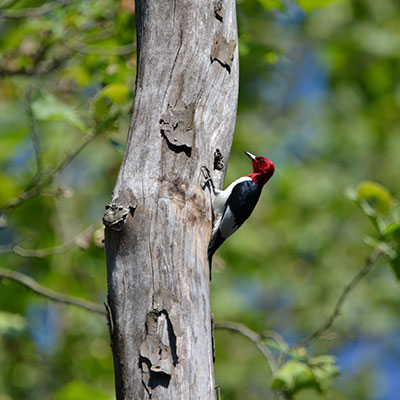
A red-headed woodpecker forages on a dead tree.
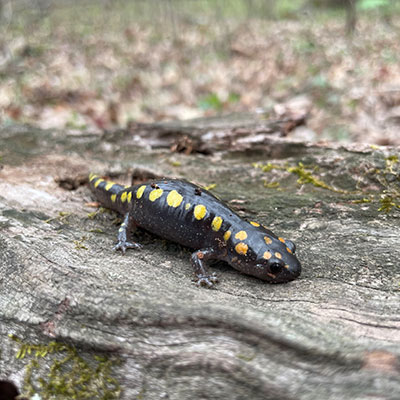
A spotted salamander rests on a log.

- Water management in marshes: Meeting the needs of migratory birds and people throughout the year
Between the Ohio River and Hovey Lake lies Rail Marsh, one of the richest and largest marshes in the area. Zach Schoenherr, property manager of Hovey Lake Fish & Wildlife Area (FWA), works with the U.S. Army Corps of Engineers to support the habitat’s abundance of native plants that feed migratory birds and waterfowl species. By disturbing the soil and controlling the amount of water in the marsh throughout the year, Schoenherr helps maintain a haven for migratory waterfowl. In Rail Marsh, waterfowl can forage, roost, and hide from predators in vegetation.
Schoenherr takes pride in the project for several reasons. Most important, he values its cyclical nature and being able to witness the entire process, watching both people and wildlife benefit. After he drains the marsh every spring, its vegetation thrives, and different creatures inhabit the space before the marsh is flooded in the fall for the arrival of waterfowl migrating south. He also watches people recreate in the area throughout the year. “Offering quality habitat for the local flora and fauna is so important,” Schoenherr says. “It feels good to help keep that moving in the right direction.”
Learn more about Hovey Lake FWA.
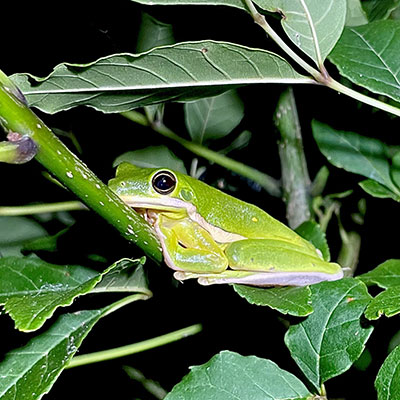
A green treefrog sits on a branch at Rail Marsh.
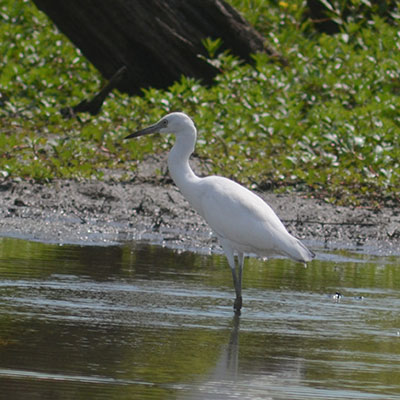
A little blue heron is a migratory visitor at Rail Marsh.

Additional Resources
- Want to learn more about other fish and wildlife that live in Indiana?
- Read about this region in the Indiana State Wildlife Action Plan.
